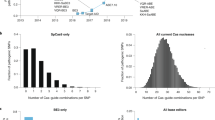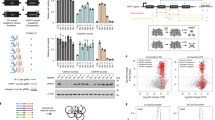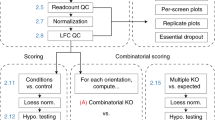Abstract
CRISPR-Cas9–based genetic screens are a powerful new tool in biology. By simply altering the sequence of the single-guide RNA (sgRNA), one can reprogram Cas9 to target different sites in the genome with relative ease, but the on-target activity and off-target effects of individual sgRNAs can vary widely. Here, we use recently devised sgRNA design rules to create human and mouse genome-wide libraries, perform positive and negative selection screens and observe that the use of these rules produced improved results. Additionally, we profile the off-target activity of thousands of sgRNAs and develop a metric to predict off-target sites. We incorporate these findings from large-scale, empirical data to improve our computational design rules and create optimized sgRNA libraries that maximize on-target activity and minimize off-target effects to enable more effective and efficient genetic screens and genome engineering.
This is a preview of subscription content, access via your institution
Access options
Subscribe to this journal
Receive 12 print issues and online access
$209.00 per year
only $17.42 per issue
Buy this article
- Purchase on Springer Link
- Instant access to full article PDF
Prices may be subject to local taxes which are calculated during checkout






Similar content being viewed by others
Accession codes
References
Jinek, M. et al. A programmable dual-RNA-guided DNA endonuclease in adaptive bacterial immunity. Science 337, 816–821 (2012).
Mali, P. et al. RNA-guided human genome engineering via Cas9. Science 339, 823–826 (2013).
Cong, L. et al. Multiplex genome engineering using CRISPR/Cas systems. Science 339, 819–823 (2013).
Jinek, M. et al. RNA-programmed genome editing in human cells. eLife 2, e00471 (2013).
Hartenian, E. & Doench, J.G. Genetic screens and functional genomics using CRISPR/Cas9 technology. FEBS J. 282, 1383–1393 (2015).
Shalem, O. et al. Genome-scale CRISPR-Cas9 knockout screening in human cells. Science 343, 84–87 (2014).
Wang, T., Wei, J.J., Sabatini, D.M. & Lander, E.S. Genetic screens in human cells using the CRISPR-Cas9 system. Science 343, 80–84 (2014).
Koike-Yusa, H., Li, Y., Tan, E.-P., Velasco-Herrera, Mdel.C. & Yusa, K. Genome-wide recessive genetic screening in mammalian cells with a lentiviral CRISPR-guide RNA library. Nat. Biotechnol. 32, 267–273 (2014).
Fu, Y. et al. High-frequency off-target mutagenesis induced by CRISPR-Cas nucleases in human cells. Nat. Biotechnol. 31, 822–826 (2013).
Veres, A. et al. Low incidence of off-target mutations in individual CRISPR-Cas9 and TALEN targeted human stem cell clones detected by whole-genome sequencing. Cell Stem Cell 15, 27–30 (2014).
Ran, F.A. et al. Double nicking by RNA-guided CRISPR Cas9 for enhanced genome editing specificity. Cell 154, 1380–1389 (2013).
Guilinger, J.P., Thompson, D.B. & Liu, D.R. Fusion of catalytically inactive Cas9 to FokI nuclease improves the specificity of genome modification. Nat. Biotechnol. 32, 577–582 (2014).
Hsu, P.D. et al. DNA targeting specificity of RNA-guided Cas9 nucleases. Nat. Biotechnol. 31, 827–832 (2013).
Doench, J.G. et al. Rational design of highly active sgRNAs for CRISPR-Cas9-mediated gene inactivation. Nat. Biotechnol. 32, 1262–1267 (2014).
Sanjana, N.E., Shalem, O. & Zhang, F. Improved vectors and genome-wide libraries for CRISPR screening. Nat. Methods 11, 783–784 (2014).
Whittaker, S.R. et al. A genome-scale RNA interference screen implicates NF1 loss in resistance to RAF inhibition. Cancer Discov. 3, 350–362 (2013).
Bollag, G. et al. Clinical efficacy of a RAF inhibitor needs broad target blockade in BRAF-mutant melanoma. Nature 467, 596–599 (2010).
Johannessen, C.M. et al. COT drives resistance to RAF inhibition through MAP kinase pathway reactivation. Nature 468, 968–972 (2010).
Davies, B.R. et al. AZD6244 (ARRY-142886), a potent inhibitor of mitogen-activated protein kinase/extracellular signal-regulated kinase kinase 1/2 kinases: mechanism of action in vivo, pharmacokinetic/pharmacodynamic relationship, and potential for combination in preclinical models. Mol. Cancer Ther. 6, 2209–2219 (2007).
Storey, J.D. & Tibshirani, R. Statistical significance for genomewide studies. Proc. Natl. Acad. Sci. USA 100, 9440–9445 (2003).
Li, W. et al. MAGeCK enables robust identification of essential genes from genome-scale CRISPR/Cas9 knockout screens. Genome Biol. 15, 554 (2014).
Lawrence, M.S. et al. Discovery and saturation analysis of cancer genes across 21 tumour types. Nature 505, 495–501 (2014).
Bae, S. et al. TRIAD1 inhibits MDM2-mediated p53 ubiquitination and degradation. FEBS Lett. 586, 3057–3063 (2012).
Gamper, A.M. & Roeder, R.G. Multivalent binding of p53 to the STAGA complex mediates coactivator recruitment after UV damage. Mol. Cell. Biol. 28, 2517–2527 (2008).
Hart, T., Brown, K.R., Sircoulomb, F., Rottapel, R. & Moffat, J. Measuring error rates in genomic perturbation screens: gold standards for human functional genomics. Mol. Syst. Biol. 10, 733 (2014).
Subramanian, A. et al. Gene set enrichment analysis: a knowledge-based approach for interpreting genome-wide expression profiles. Proc. Natl. Acad. Sci. USA 102, 15545–15550 (2005).
Wang, T. et al. Identification and characterization of essential genes in the human genome. Science 350, 1096–1101 (2015).
Caskey, C.T. & Kruh, G.D. The HPRT locus. Cell 16, 1–9 (1979).
Brinkman, E.K., Chen, T., Amendola, M. & van Steensel, B. Easy quantitative assessment of genome editing by sequence trace decomposition. Nucleic Acids Res. 42, e168 (2014).
Zha, M. et al. Molecular mechanism of ADP-ribose hydrolysis by human NUDT5 from structural and kinetic studies. J. Mol. Biol. 379, 568–578 (2008).
Cheok, M.H. & Evans, W.E. Acute lymphoblastic leukaemia: a model for the pharmacogenomics of cancer therapy. Nat. Rev. Cancer 6, 117–129 (2006).
Barretina, J. et al. The Cancer Cell Line Encyclopedia enables predictive modelling of anticancer drug sensitivity. Nature 483, 603–607 (2012).
Liberzon, A. et al. Molecular signatures database (MSigDB) 3.0. Bioinformatics 27, 1739–1740 (2011).
Shi, J. et al. Discovery of cancer drug targets by CRISPR-Cas9 screening of protein domains. Nat. Biotechnol. 33, 661–667 (2015).
Chari, R., Mali, P., Moosburner, M. & Church, G.M. Unraveling CRISPR-Cas9 genome engineering parameters via a library-on-library approach. Nat. Methods 12, 823–826 (2015).
Xu, H. et al. Sequence determinants of improved CRISPR sgRNA design. Genome Res. 25, 1147–1157 (2015).
Jinek, M. et al. Structures of Cas9 endonucleases reveal RNA-mediated conformational activation. Science 343, 1247997 (2014).
Sternberg, S.H., Redding, S., Jinek, M., Greene, E.C. & Doudna, J.A. DNA interrogation by the CRISPR RNA-guided endonuclease Cas9. Nature 507, 62–67 (2014).
Bae, S., Kweon, J., Kim, H.S. & Kim, J.-S. Microhomology-based choice of Cas9 nuclease target sites. Nat. Methods 11, 705–706 (2014).
Gilbert, L.A. et al. Genome-scale CRISPR-mediated control of gene repression and activation. Cell 159, 647–661 (2014).
Lin, Y. et al. CRISPR/Cas9 systems have off-target activity with insertions or deletions between target DNA and guide RNA sequences. Nucleic Acids Res. 42, 7473–7485 (2014).
Stemmer, M., Thumberger, T., Del Sol Keyer, M., Wittbrodt, J. & Mateo, J.L. CCTop: an intuitive, flexible and reliable CRISPR/Cas9 target prediction tool. PLoS One 10, e0124633–e11 (2015).
Tsai, S.Q. et al. GUIDE-seq enables genome-wide profiling of off-target cleavage by CRISPR-Cas nucleases. Nat. Biotechnol. 33, 187–197 (2015).
Langmead, B. & Salzberg, S.L. Fast gapped-read alignment with Bowtie 2. Nat. Methods 9, 357–359 (2012).
Heigwer, F., Kerr, G. & Boutros, M. E-CRISP: fast CRISPR target site identification. Nat. Methods 11, 122–123 (2014).
Bae, S., Park, J., Kim, J.S. & Kim, J.S. Cas-OFFinder: a fast and versatile algorithm that searches for potential off-target sites of Cas9 RNA-guided endonucleases. Bioinformatics 30, 1473–1475 (2014).
Kampmann, M. et al. Next-generation libraries for robust RNA interference-based genome-wide screens. Proc. Natl. Acad. Sci. USA 112, E3384–E3391 (2015).
Steiger, J.H. Tests for comparing elements of a correlation matrix. Psychol. Bull. 87, 245–251 (1980).
Blasi, E., Radzioch, D., Durum, S.K. & Varesio, L. A murine macrophage cell line, immortalized by v-raf and v-myc oncogenes, exhibits normal macrophage functions. Eur. J. Immunol. 17, 1491–1498 (1987).
Stansley, B., Post, J. & Hensley, K. A comparative review of cell culture systems for the study of microglial biology in Alzheimer's disease. J. Neuroinflammation 9, 115 (2012).
Ben-Hur, A., Ong, C.S., Sonnenburg, S., Schölkopf, B. & Rätsch, G. Support vector machines and kernels for computational biology. PLoS Comput. Biol. 4, e1000173 (2008).
Cock, P.J.A. et al. Biopython: freely available Python tools for computational molecular biology and bioinformatics. Bioinformatics 25, 1422–1423 (2009).
Le Novère, N. MELTING, computing the melting temperature of nucleic acid duplex. Bioinformatics 17, 1226–1227 (2001).
Steiger, J.H. Tests for comparing elements of a correlation matrix. Psychol. Bull. 87, 245–251 (1980).
Acknowledgements
We thank M. Tomko, M. Greene, A. Brown, D. Alan and T. Green for software engineering support, and T. Nguyen, N. Tran and X. Yang for library production support (Broad Institute). Z.T. is funded by NIH 5K12CA087723-12, ASCO Young Investigator Award, LLS Special Fellow Award. J.G.D. is a Merkin Institute Fellow and is supported by the Next Generation Fund at the Broad Institute of MIT and Harvard.
Author information
Authors and Affiliations
Contributions
J.G.D., M.S., E.W.V., Z.T., C.W. and R.O. designed experiments; M.S., E.W.V., K.F.D., Z.T., C.W. and R.O. performed experiments; J.G.D., M.H. and I.S. analyzed experiments; N.F. and J.L. performed the computational modeling; J.G.D., N.F., J.L. and D.E.R. wrote the manuscript with assistance from other authors; J.G.D., H.W.V. and D.E.R. supervised the research.
Corresponding authors
Ethics declarations
Competing interests
N.F. and J.L. are employed by Microsoft Research.
Supplementary information
Supplementary Figures
Supplementary Figures 1–22 (PDF 2195 kb)
Supplementary Tables 1–23
Supplementary Table 1. Rounds of selection used to design Avana and Asiago library Supplementary Table 2. sgRNAs in the six subpools of Avana library Supplementary Table 3. sgRNAs in the six subpools of Asiago library Supplementary Table 4. Screening data for vemurafenib in A375 cells for all biological replicates screened with Avana libraries (divided by subpools) as well as GeCKOv1 and GeCKOv2 libraries Supplementary Table 5. RIGER analysis of vemurafenib screens using weighted-sum option Supplementary Table 6. STARS analysis of vemurafenib screens Supplementary Table 7. List of PanCancer genes Supplementary Table 8. Screening data for selumetinib in A375 cells for all biological replicates screened with Avana library Supplementary Table 9. STARS analysis of selumetinib screens Supplementary Table 10. Negative selection screening data in HT29 and A375 cells with GeCKO libraries Supplementary Table 11. Negative selection screening data in HT29 and A375 cells with GeCKO libraries and the set of 291 core essential genes annotated by Hart and colleagues Supplementary Table 12. STARS analysis of the negative selection screening data for GeCKO and Avana libraries individually Supplementary Table 13. STARS analysis of the negative selection screening data for GeCKO and Avana libraries merged Supplementary Table 14. Screening data for 6-thioguanine screen in 293T, A375 and HT29 cells Supplementary Table 15. Screening data for interferon-gamma treatment of BV2 cells and output of STARS analysis Supplementary Table 16. Screening data for the tiling of resistance genes Supplementary Table 17. Gini importance of individual features in the gradient-boosted regression tress model, Rule Set 2 Supplementary Table 18. Screening data for off-target analysis of CD33 in MOLM13 cells Supplementary Table 19. Percent-active, delta-log-fold-change, and one-sided Welch's t-test p-value calculations for the CD33 off-target dataset that is used to calculate the CFD score Supplementary Table 20. Activity of sgRNAs designed against H2-D1 that have up to 6 mismatches to H2-K Supplementary Table 21. sgRNAs in the Brunello library Supplementary Table 22. sgRNAs in the Brie library Supplementary Table 23. sgRNA sequences and primers used for individual follow-up experiments (ZIP 125249 kb)
Rights and permissions
About this article
Cite this article
Doench, J., Fusi, N., Sullender, M. et al. Optimized sgRNA design to maximize activity and minimize off-target effects of CRISPR-Cas9. Nat Biotechnol 34, 184–191 (2016). https://doi.org/10.1038/nbt.3437
Received:
Accepted:
Published:
Issue Date:
DOI: https://doi.org/10.1038/nbt.3437
This article is cited by
-
Comprehensive review of CRISPR-based gene editing: mechanisms, challenges, and applications in cancer therapy
Molecular Cancer (2024)
-
Improved prediction of bacterial CRISPRi guide efficiency from depletion screens through mixed-effect machine learning and data integration
Genome Biology (2024)
-
The CUL5 E3 ligase complex negatively regulates central signaling pathways in CD8+ T cells
Nature Communications (2024)
-
Multiplexed screening reveals how cancer-specific alternative polyadenylation shapes tumor growth in vivo
Nature Communications (2024)
-
A SWI/SNF-dependent transcriptional regulation mediated by POU2AF2/C11orf53 at enhancer
Nature Communications (2024)



